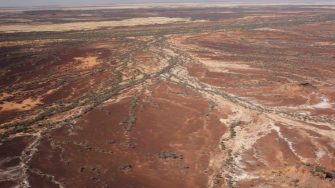
Date: Friday, October 10, 2014
Project: Eastern Australian Waterbird Survey
Observer: Richard Kingsford
Today is always our longest and hottest day of our month and a half survey, as we head east along Band 9, starting 200km south of Mt Isa. We started early, getting up with the full moon and taking off with the rising sun.
Photo 1. Mt Isa at daybreak with the lights still on.
Lake Katherine, one of the deep long waterholes on the Georgina River, was our first wetland. This river’s water can eventually make it to Lake Eyre, joining Eyre Creek and then the Diamantina River, south of Birdsville, before they form the Warburton River running into Lake Eyre. That hasn’t happened since 2010-2011.
Photo 2. Lake Katherine, a waterhole along the Georgina River through a very wide angle lens.
Surveying waterbirds along Lake Katherine on the Georgina River
Our easterly flight was uneventful to Winton, bumping along at about fifteen hundred feet above the ground, because there was so little water. When we survey waterbirds, we fly at about 150 feet or 50 metres, the ideal height for identifying up to 50 different waterbird species. We crossed the Diamantina River with as many as 20 major channels running north to south. None were large or deep enough for waterbirds. We will cross the river twice more in the next week, each time another 200km further south. We landed at Winton for lunch.
Photo 3. Dry river and creek channels crisscross this landscape but when the floods come they carry water occasionally to Lake Eyre
Back into the plane with a strong northerly blowing, doubling our bumps. Nothing much to see in the first hour – just a few waterholes and almost empty dams. Lake Dunn just north of the town of Aramac always had water, as it nearly always does. It is refreshing to get our vocal chords working again on the wood ducks, grey teal pelicans, white faced herons. There were also about a hundred freckled duck, one of our rarer species. This is also brolga habitat and about 20 took off to the north. This turned out to be just a warm up for Lake Galilee to the north.
Photo 4. Lake Dunn nearly always has water and is rich in waterbird diversity
Lake Galilee is a vast salt lake. We had looked at the satellite images before the survey. They were equivocal about whether there was water. It was soon obvious that the southwestern and southeastern corners of the lake had water.
Photo 5. Lake Galilee with only patches of water but still highly productive for waterbirds
There were an astounding number of waterbirds speckling the water in all directions. Coming into our survey – deep breaths all round and a few voice exercises. You cant afford to stop talking into the tape recorded when there are this many waterbirds. For half an hour we went at it with swirling flocks of grey teals, well over twenty thousand, hardhead and pink-eared duck. There were also plenty of swans and pelicans. I never tire of this job when it is like this. There are few more wonderful places in this country than this lake when it has water. It is undoubtedly one of Australia’s most important wetlands for waterbirds.
Photo 6. Waterbirds everywhere in the tens of thousands – one of the most thrilling sites we have the privilege to see.
Video caption – Lake Galilee is one of Australia’s most important wetlands for waterbirds, often dominating our counts across eastern Australia.
This was undoubtedly the highlight so far when it comes to waterbirds. We headed east, picking up more farm dams and the odd lagoon, each with no more than about twenty to thirty waterbirds. Overnight in Rockhampton, then a rest day. Sunday – we will head west again along Band 8. The red line on the map below showed where we surveyed.
